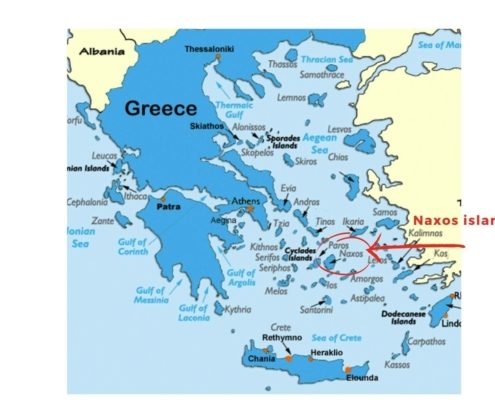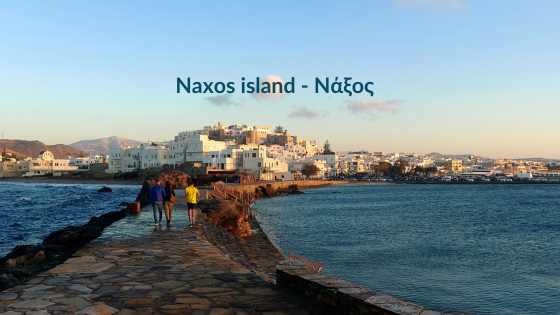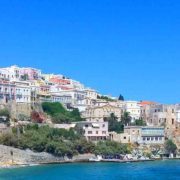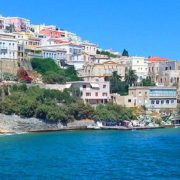Naxos island is the largest island of the Cyclades island group in the Aegean Sea.
It is known for its beautiful beaches, ancient ruins, and rich history, as well as its production of marble and agricultural products. Naxos is a popular tourist destination, attracting visitors with its scenic landscapes, traditional villages, and vibrant culture.
At Omilo, we are teaching our summer courses on the island of Syros, since 2005, from where we can see Naxos island, with clear weather.
A little bit of history about Naxos…
The history of Naxos is rich and varied, dating back to prehistoric times. In ancient times, Naxos was a major centre of worship for the cult of Dionysus, the god of wine and fertility. As a result, the island was famous for its wine production.
According to Greek mythology, Theseus on his way back to Athens after killing the Minotaur in Crete stopped at Naxos to rest. He had with him the beautiful daughter of the king of Crete Minoas, Ariadne, who helped him navigate the maze where the Minotaur was hidden. When Dionysus saw Ariadne, he instantly fell in love with her and appeared in Theseus’ dream and persuaded him to leave her behind in Naxos. When she was finally abandoned and alone, Dionysus appeared in front of her and made her his wife.
Moreover, even though Zeus, the king of the Olympians, was born in Crete, he was raised in Naxos. Its inhabitants worshipped him and gave his name to the highest mountain of the island, which is called Zas.
In the 5th century BCE, the island became a democracy, i.e. an autonomous city-state, and played a significant role in the development of the ancient Greek civilization. Proof of the island’s powerful position can be found in locations all over Greece in the form of sculptures, such as the Naxian Colossus, a 9-metre tall sculpture of a man in the nearby island of Delos, as well as the marble Sphinx of the Naxians, the Lions of Delos, Oikos and the Arcade of the Naxians in Delphi. [You can read more about Delphi here.]
In the Middle Ages, Naxos was ruled by the Venetians, along with other parts of Greece and the Aegean, for over four centuries, from 1204 to 1797 (in Naxos they stayed for only two centuries, though). The Venetians left their mark on the island in the form of castles, churches, and other architectural landmarks. They were the ones who introduced elements of the Renaissance architecture style to Naxos. Many of the churches, palaces, and public buildings on the island were built in the Venetian style during this period.
The Venetian rule in Naxos also had a major impact on the island’s economy and society. The Venetians introduced new crops, such as oranges and lemons, which became important crops in Naxos. The island also became a hub for trade and commerce in the Aegean, and Naxos became a prosperous and culturally rich island.
After the fall of the Venetian Republic, Naxos became part of the Ottoman Empire and later, the Greek state.

The Castle of Naxos – a testament to the island’s rich history
The castle of Naxos, also known as “to Kastro”, is a medieval fortress located in the capital of Naxos, Chora. The castle was built in the 7th century by Byzantine settlers and was later expanded by Venetian rulers in the 13th century. The castle served as a stronghold for the Venetian occupation of Naxos and played a significant role in the island’s history.
The castle of Naxos is well-preserved and offers stunning views of the surrounding town and countryside. Within the castle walls, visitors can explore the remains of Venetian houses, churches, and other buildings, as well as the old market, which was once the centre of commerce on the island. The castle also features a museum showcasing the history of Naxos and the Cyclades.
Beach life
Naxos is known for its beautiful beaches, which range from secluded coves to long stretches of golden sand. Some of the most popular beaches on the island include:
- Plaka Beach: A long, sandy beach located on the southern coast of Naxos, known for its crystal-clear waters and great windsurfing conditions.
- Agia Anna: A popular beach located on the south coast of Naxos, Greece. It is known for its golden sand and crystal-clear waters, and is a popular destination for families.
- Agios Prokopios: A stunning, sandy beach on the north coast of Naxos, surrounded by lush greenery and crystal-clear waters.
- Mikri Vigla: Another well-known beach on the southern coast of Naxos, known for its excellent conditions for windsurfing and kitesurfing.
- Orkos: A secluded beach on the western coast of Naxos, surrounded by dramatic cliffs and crystal-clear waters.
- George: A long, sandy beach on the northern coast of Naxos, known for its shallow waters and great windsurfing conditions.
The Catholic community of Naxos
While Greece is predominantly Greek Orthodox, there is a small minority of Catholics in Naxos – similarly to Syros, where the Omilo summer courses are held.
(FYI In Syros, about 40% of the population is catholic. Ano Syros is the island’s Medieval settlement, and it looks like a fortified citadel. It was built in 1200 by the Venetians.)
The exact number of Catholics in Naxos is not known, but they are a small minority among the overall population. The Catholic community in Naxos is served by a church as well as religious orders, such as the Ursuline Sisters.
Specifically, they operated the Ursulines School, which was founded by Jesuits during the 17th century and is located inside Kastro (the Castle), near the Catholic Cathedral. The school started operating in 1628 under the supervision of the Jesuit monks who had arrived in Naxos due to the extension of French diplomacy at that time. Its aim was to offer the Catholic youth of Naxos quality education and eventually it established the reputation of one of the best schools in Greece.
In 1985, the school building became property of the Greek State. It was restored and has since operated as a cultural centre that educates visitors about the island’s history and traditions, hosts cultural events, festivals and many more. The Ursulines have kept a part of the complex and use it during the summer season for seminars, religious retreats, and other events.
How to get to Naxos?
Naxos has an airport, the Naxos Island National Airport, which offers flights to and from Athens and other Greek cities, as well as seasonal flights to international destinations . Moreover, Naxos is well connected by ferry to other Greek islands and the mainland. There are daily ferry services from Piraeus (the port of Athens) and other islands in the Cyclades, such as Mykonos, Santorini, and Ios. Regardless of the mode of transportation, it’s a good idea to check the schedules and availability in advance, especially during the high season, as they can change frequently.
Learning Greek on Naxos island
Interested to join Omilo, and book a Greek Language and Culture course on Naxos island, during the month of October?
Then click here for more info
+++++++++++++++++++++++
Listening to a Podcast story, taking place in Naxos
Are you interested to listen to a podcast story, for intermediate language level in Greek?
Then here you can listen to a story, taking place in Naxos
Download the notebook for FREE, including podcast links, YouTube video, etc..
Click here, and have fun while learning Greek







